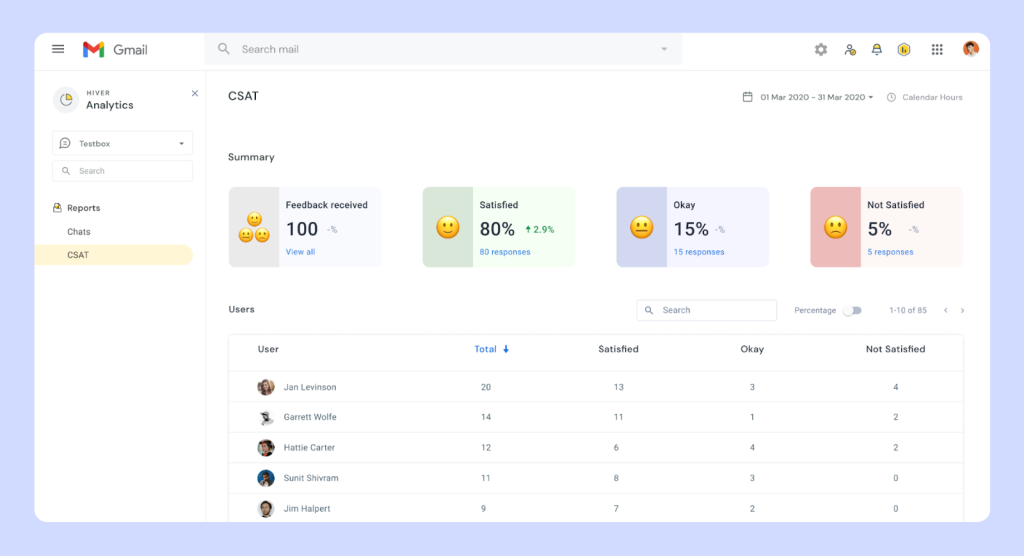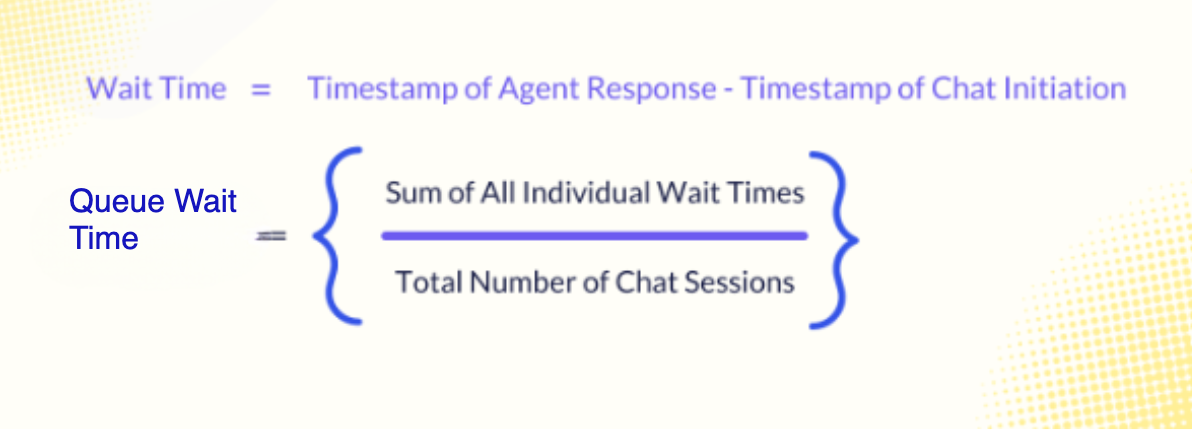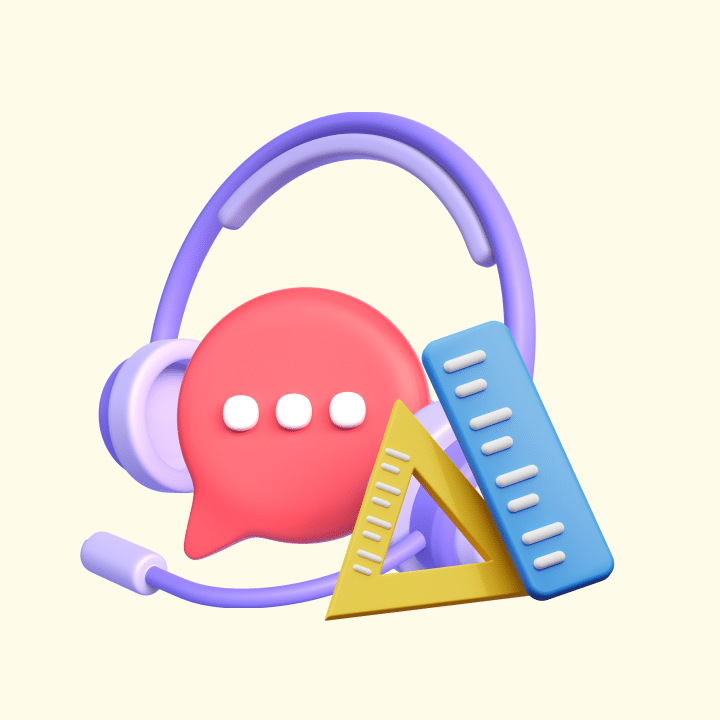Live chat has become the preferred way for customers to get instant support and quick answers. However, adding a chat widget isn’t always enough. You need to know if it’s actually helping customers and your team.
Live chat metrics help you do that by showing how quickly your team responds, how often you resolve issues, and how satisfied customers feel. These insights also help spot areas to improve and create a smoother customer support experience every time.
But which metrics are most important to determine whether your live chat works? Let’s take a look at the most important ones.
Table of Contents
- What are Live Chat Metrics?
- 10 Key Live Chat Metrics to Measure in 2025
- What are the Benefits of Measuring Live Chat Metrics
- What are the Common Challenges of tracking Live Chat Metrics?
- Next Steps to Improve Your Live Chat Performance
- FAQ
What are Live Chat Metrics?
Live chat metrics are the data points that show how well your chat support is performing. They track things like response times, resolution rates, customer satisfaction, and chat volumes. Think of them as a performance dashboard for your support team.
For example, the feedback rate is an important metric in live chat that tracks how many customers share their opinions after a chat.
If 100 people finish a chat and 80 leave a “Satisfied” rating, 15 say “Okay,” and five choose “Not Satisfied,” you immediately see both the volume of feedback and the overall sentiment. This data helps you identify what’s working and where you need to improve.

Why are live chat metrics important?
Measuring live chat metrics provides a clear roadmap for growth and improvement. The data shows where the chat process breaks down and where you can improve. It helps you spot ways to enhance customer experience, boost team efficiency, and drive better business results.
10 Key Live Chat Metrics to Measure in 2025
Here are 10 metrics to help you gauge the effectiveness of your live chat support and get insights into how you can optimize it for higher customer engagement.
1. Chat Response Time
Chat Response Time is the average time it takes for an agent to reply to customer messages during a live chat session. Most live chat tools display this metric in their analytics dashboard, where you can filter by agent, date, or time period to identify challenges.

A short chat response time is important for maintaining a positive user experience. Long response times lead to customer frustration, potentially impacting their overall perception of the brand or service.
How to improve chat response time:
- Use canned responses for greetings and FAQs so agents can reply instantly.
- Staff around peak hours are identified in your analytics to prevent long waits.
- Leverage AI Copilot to auto-suggest quick, accurate responses.
How to measure it:
To measure chat response time, use this formula:

Recommended reading
2. Chat Duration
Chat Duration is the total length of a live chat session, measured from when a customer initiates the conversation until it is closed by either the agent or the customer.
It highlights how long typical interactions last and can vary depending on issue complexity, agent efficiency, and customer engagement.
Why it matters:
Chat length gives valuable insight into customer experience and support quality. If the customer leaves the chat soon, they abandon the conversation, while lengthy chats indicate inefficiencies.
The ideal duration is balanced, where the customer gets the right answer.
How to improve chat duration:
- For live agents: Train them to ask clear questions early and use internal knowledge bases so issues won’t take much time.
- For chatbots: Optimize conversation flows and FAQs so customers get the right answer faster without looping back.
- Track patterns: For example, create playbooks or automated flows if certain query types take longer.
How to measure it:
To measure chat duration, use this formula:

3. First Contact Resolution Rate
First Contact Resolution Rate (FCR) measures the percentage of customer issues resolved in the first chat interaction, without needing follow-ups via chat, email, or phone.
Why it matters:
A high FCR rate is a good sign that your customers are getting their questions answered swiftly, without being bounced around or having to repeat the same concern. Low FCR, on the other hand, signals gaps in training, knowledge resources, or routing.
How to improve first contact resolution rate:
- Set clear concurrency limits so agents don’t take on more chats than they can handle.
- Enable proactive chat triggers to engage customers before they drop off.
- Offer fallback options (like email capture or call scheduling)
How to measure it:
To measure the first contact resolution rate, use this formula:

For instance, if you had 80 chats resolved on first contact out of a total of 100 chats, your FCR rate would be:
(80/100) x 100 = 80%
Recommended reading
4. Active and Missed Chats
Active Chats are the ongoing, real-time conversations your team is handling at any given moment. Missed Chats are customer-initiated requests that don’t receive a timely response, either because agents were unavailable or the customer left before being assisted.
Why it matters:
Active chat volume helps you understand agent workload and customer demand. Missed chats, on the other hand, are costly. They signal lost opportunities to resolve issues or convert prospects, often leaving customers with a negative impression of your support.
How to improve active and missed chats:
- Set concurrency rules so agents can manage more chats effectively.
- Add proactive triggers like offering help when a customer lingers on checkout.
- Monitor peak times and align staffing accordingly.
For instance, Hiver’s Live Chat notifies customers right inside the live chat widget if no agents are available. At the same time, your team receives instant alerts about missed chats. This way, customers know what to do next, like switching to email, and your team can stay on top of every conversation without losing track.
How to measure it:
- Determine what time frame you consider “active.” For instance, some businesses might consider a chat to remain “active” if there’s been a message in the last 5 minutes, while others might use a different duration.
- You can also make use of the chat statuses provided by the live chat platform. Chats typically have statuses like “waiting,” “ongoing,” or “ended.” By filtering out just the “ongoing” chats, you can determine the number of active chats.
5. Feedback Rate
Feedback rate measures the percentage of chat sessions where customers leave feedback, whether through ratings, comments, or surveys, compared to the total number of sessions.
Why it matters:
A higher feedback rate means more customer insights to work with. It helps you understand how customers perceive agent performance, identify friction points in chat flows, and track satisfaction trends over time.
Low feedback rates, on the other hand, leave you guessing about whether customers are truly happy with your service.
How to improve feedback rate:
- Keep surveys short and simple. Example: Star rating or thumbs up/down.
- Ask for feedback immediately after a chat ends.
- Close the loop by showing customers their input, which leads to improvements.
How to measure it:
To measure feedback rate, use this formula:

6. Chat Abandonment Rate
Chat abandonment rate is the share of chats customers leave before reaching an agent or getting a resolution.
Why it matters:
Each abandoned chat may represent missed opportunities, either in sales, upsells, or improving customer satisfaction. A high abandonment rate may indicate that customers are not having a positive experience, possibly due to long wait times or technical issues.
How to improve chat abandonment rate:
- Shorten queue times by staffing better during peak hours.
- Offer self-service options like FAQs or chatbots while customers wait.
- Set expectations upfront with real-time wait time indicators (“Average wait: 1 min”).
How to measure it:
To measure chat abandonment rate, use this formula:

7. Agent Utilization Rate
Agent utilization rate measures the percentage of an agent’s available work time that is spent actively handling live chat conversations.
Why it matters:
The metric shows how effectively your team’s time is being used. A low utilization rate means overstaffing or idle time. Too high can mean agents are overloaded, leading to declining service quality.
How to improve agent utilization rate:
- Set healthy utilization benchmarks (Example: 60–70% is sustainable for support teams).
- Balance workloads by distributing chats evenly across agents.
How to measure it:
To measure chat agent utilization rate, use this formula:
- Active Chat Time: It’s the total time an agent spends in active chat sessions, handling customer inquiries.
- Total Working Time: It’s the total time an agent is logged in and available for chat, including both active chat time and idle/waiting time.

8. Queue Wait Time or Average Wait Time
Queue Wait Time (also called Average Wait Time) is the average amount of time a customer spends waiting in the live chat queue before being connected to an agent.
Why it matters:
A customer waiting for a longer period of time will get frustrated, even if the customer support is excellent. A slow start often shapes the entire experience negatively. Keeping this number low is critical for customer satisfaction and first impressions.
How to improve queue wait time:
- Use historical data to identify peak hours and align scheduling.
- Connect customers to the right agent or department immediately instead of passing them around.
- Let chatbots or junior agents handle simple queries while specialists focus on complex ones.
How to measure it:
To measure queue wait time, use this formula:
- Measure the individual wait times for customers by subtracting the time from when the chat was initiated from the time when an agent responds to the chat
- Add up all the individual wait times for a given period (Ex, a day, a week, or a month)
- Divide this number by the total number of chat sessions in that period

9. Conversion Rate
Conversion Rate in live chat measures the percentage of chat interactions that lead to a desired outcome, such as a purchase, sign-up, demo booking, or successful lead capture. The specific “conversion” can vary based on the business’s goals and the purpose of the live chat.
Why it matters:
Monitoring live chat conversion rates helps businesses understand the effectiveness of their chat interactions. A high conversion rate means your agents (chatbots) effectively guide customers toward action.
If conversion rates are low, the chat workflows or scripts that agents use might need improvement.
How to improve conversion rate:
- Train agents in consultative selling so they can recommend the right products or solutions during chats.
- Trigger chat invitations on high-intent pages like pricing or checkout.
- Optimize chat scripts to include soft CTAs (e.g., “Would you like me to set up a demo?”)
How to measure it:
- Define what constitutes a “conversion” for your business within live chat. It could be a sale, a sign-up, or support ticket resolution.
- Track the number of successful conversions that result directly from chat interactions within a specific period.
- Collect data on the total number of chat sessions that occurred in the same period.

10. Peak Chat Time
Peak chat time refers to the specific hours or days when the volume of chat requests is higher than usual. It helps teams understand when customers are most likely to reach out.
Why it matters:
Peak chat times align with operating hours, promotions, or seasonal demand. Tracking them helps you spot spikes in volume, anticipate operational challenges, and staff accordingly. When you manage it well, there are also opportunities to engage more customers and drive higher conversions.
How to improve peak chat time:
- Analyze historical data to spot recurring busy periods.
- Align staffing schedules so more agents are available during peaks.
- Use chatbots to handle simple queries instantly when volume surges.
- Monitor special events or campaigns, which often trigger sudden spikes in chat volume.
How to measure it:
There’s no single formula; peak times are identified by tracking chat volumes over time and spotting patterns (Example: Daily, weekly, or seasonal spikes)
What are the Benefits of Measuring Live Chat Metrics
Measuring live chat metrics is crucial for businesses that wish to offer impeccable customer support and optimize their support operations.
By tracking these metrics, businesses can gauge the effectiveness of their live chat tool, make data-driven decisions, improve agent performance, and continually enhance the customer experience. Here’s why measuring live chat metrics is so essential:
- Enhancing Customer Satisfaction: Monitoring metrics like customer satisfaction scores (CSAT) provides direct feedback on user experiences. By addressing areas of dissatisfaction, businesses can improve customer loyalty and drive positive brand perceptions.
- Efficiency and Productivity: Metrics such as average response time and average resolution time offer insights into support agents’ efficiency. These metrics help identify areas where training might be required or resources need to be reallocated.
- Resource Allocation: Analyzing metrics like chat volume, peak chat times, and the number of chats per agent helps businesses better allocate resources, ensuring that support staff are available during high-demand periods.
- Reducing Abandonment Rates: Tracking chat abandonment rates can indicate potential friction points in the live chat workflow. High abandonment might signify long wait times or inaccurate responses, prompting necessary adjustments such as more focused agent training or refining internal workflows.
- Boosting Sales and Conversions: For e-commerce businesses, live chat can be a tool for driving sales. Businesses can assess and refine their sales tactics by monitoring conversion rates from chat interactions.
What are the Common Challenges of tracking Live Chat Metrics?
Live chat metrics are invaluable for measuring performance. However, many teams struggle to use them effectively because of inherent challenges in data collection and interpretation.
- Defining the right KPIs: With numerous metrics, such as first response time, CSAT, and resolution rate, it can be challenging to determine which ones accurately reflect customer success. Focusing on vanity metrics instead of outcome-driven ones can fail to create a clear picture.
- Balancing speed with quality: Agents may rush to keep response times low, but fast replies don’t always mean helpful replies. Many teams struggle to measure both speed and satisfaction together.
- Scaling measurement as teams grow: What works for a small support team may not hold up as volume increases. Larger teams need innovative ways to track agent performance, spot training needs, and ensure consistent service.
Next Steps to Improve Your Live Chat Performance
Tracking live chat metrics shows how strong your support strategy is. They highlight where customers get stuck, how agents perform under pressure, and whether your team can handle demand smoothly.
When these metrics are measured, they improve the entire customer experience. Shorter response times, higher first-contact resolution, and smarter staffing decisions lead to happier customers and stronger loyalty.
Focus on the right metrics, and everyday chats become chances to grow and build long-term trust.
FAQ
1. How do you measure the effectiveness of live chat?
Effectiveness is measured by tracking key metrics like first response time, resolution rates, CSAT, and conversion rates. Together, these show how fast, efficient, and customer-friendly your support team is.
2. What are the key KPIs for chat support teams?
The most common KPIs include First Response Time (FRT), Average Resolution Time (ART), First Contact Resolution (FCR), Customer Satisfaction (CSAT), Chat Abandonment Rate, and Conversion Rate.
3. How do you measure customer satisfaction (CSAT) in live chat?
CSAT is measured by asking customers to rate their chat experience after a session (often on a 1–5 scale). The percentage of positive ratings against total responses gives your CSAT score.
4. What is the difference between First Response Time (FRT) and Average Resolution Time (ART)?
First response time (FRT) measures how quickly an agent replies to the initial customer message, while average resolution time (ART) fully tracks the total time to resolve the issue.
5. How do you measure First Contact Resolution (FCR) in chat?
FCR is calculated by dividing the number of chats resolved in the first interaction by the total number of chats in a given period, then multiplying by 100.
6. Which live chat metrics help improve sales conversions?
Metrics like Conversion Rate, Proactive Chat Engagement, and FCR are most useful. They show whether chats are guiding customers toward purchases or sign-ups effectively.
Start using Hiver today
- Collaborate with ease
- Manage high email volume
- Leverage AI for stellar service
 Skip to content
Skip to content












